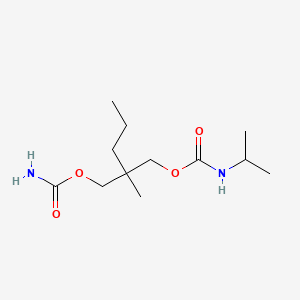|
Name: Carisoprodol
Type: Skeletal muscle relaxant
AKA: Soma

|
|
II. Natural Derivative
Synthetic substance, no natural derivative
 |
|
III. Chemical Profile (IUPAC name)

|
|
IV. History
Carisoprodol, a muscle relaxant, was first introduced in 1959. It was developed by Frank Berger at Wallace Laboratories. Carisoprodol is commonly prescribed to relieve pain and discomfort associated with musculoskeletal conditions. Its use has been widespread due to its effectiveness, though it has also been subject to abuse and dependence, leading to its classification as a controlled substance in several countries.

|
|
V. Legal Information
Carisoprodol is a muscle relaxant classified as a Schedule IV controlled substance in the US. It was reclassified in 2012 due to its potential for abuse and dependence. Globally, its legal status is similarly controlled, with restrictions on prescription and use to prevent misuse. Carisoprodol's regulation reflects broader trends of increasing scrutiny and control over substances with abuse potential.
US Federal Schedule - IV
Schedule IV drugs, substances, or chemicals are defined as drugs with a low potential for abuse and low risk of dependence. Some examples of Schedule IV drugs are: Xanax, Soma, Darvon, Darvocet, Valium, Ativan, Talwin, Ambien, Tramadol.
Key US Federal Policies:
Controlled Substances Act. Public Law: Public Law 91-513 (text can be found on GovInfo) (https://www.dea.gov/drug-information/csa). Date enacted: October 27, 1970.
|
|
VI. Physical Effects
Carisoprodol, a muscle relaxant, is used to relieve muscle spasms. As a downer, it depresses the central nervous system, leading to muscle relaxation and drowsiness. Short-term use can cause dizziness, drowsiness, and headaches, while long-term use may result in dependence and abuse. Overdose risks include severe sedation, respiratory depression, and potentially death. Safe use involves prescribed dosages, usually 250-350 mg up to three times daily. Recent studies show that while effective for muscle spasms, carisoprodol's abuse potential necessitates cautious use and monitoring.  |
|
VII. Psychological Effects
Carisoprodol, a muscle relaxant, affects central nervous system function leading to sedation and altered cognition. Its psychological effects include drowsiness and impaired motor skills. The effects last 4-6 hours, and long-term use can cause dependence and cognitive issues. Recent studies investigate its potential for misuse and impact on mental function.
 |
|
VIII. Culture
Carisoprodol, a muscle relaxant introduced in the 1950s, is known for its role in pain management and treatment of musculoskeletal conditions. Its impact is particularly noted in the United States, where it has been widely prescribed. The drug's cultural relevance is tied to the discussion of prescription drug abuse, as it has been subject to misuse and dependency issues. Notable figures, including athletes and celebrities, have brought attention to both its therapeutic benefits and risks. The dual nature of carisoprodol's impact—relief for some, abuse for others—illustrates the complex dynamics of prescription medications in contemporary society.
 |
